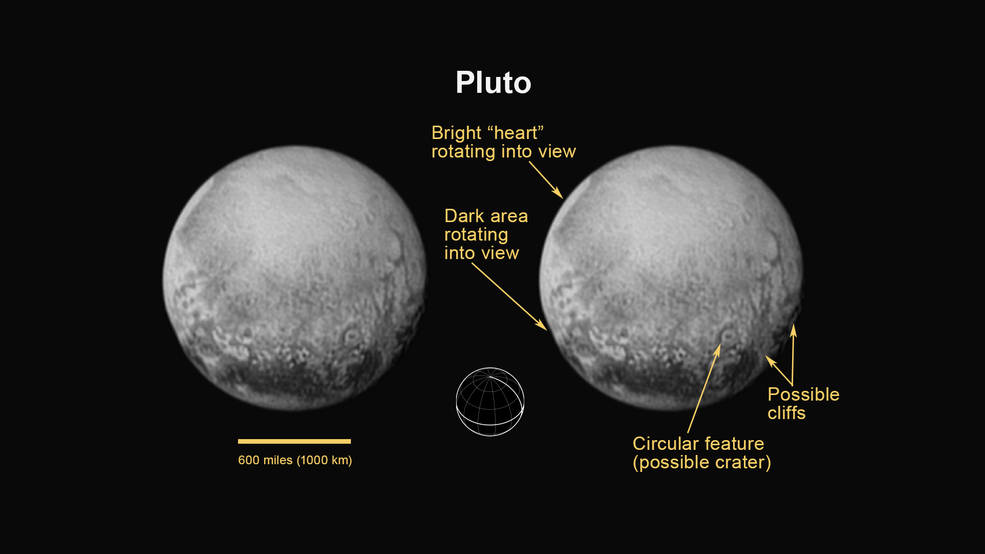
The collaborative work of several thousand people from over 50 organizations over the last decade will payoff in under 11 hours. A historic journey across the vast expanse of our Solar System, some 3 billion miles away, will culminate tomorrow morning as NASA’s New Horizons’ spacecraft fulfills its destiny by exploring Pluto, up-close and personal. The spacecraft will put its suite of seven science instruments into overdrive, and in doing so it will close out humanity’s initial reconnaissance of every major world in our small neighborhood among the stars.
At the time of publishing New Horizons’ was about 350,000 miles above the surface of Pluto. Shortly before 8 a.m. EDT tomorrow (July 14) the piano-sized, 1,000-pound spacecraft will make its closest approach, just under 7,800 miles above the planet’s surface, flying by at 31,000 mph and producing imagery of such high-resolution that features as much as 230 feet wide will be crystal clear, and 100 times better than even the most recent images from this weekend, which are already 7.8 miles per pixel in resolution.
During the flyby the images will be so clear that if New Horizons was traveling over the Earth at the same distance, it would reveal detail as small as the ponds in New York’s Central Park.

New Horizons has already completed the final Long Range Reconnaissance (LORRI) telescopic approach images, and shortly after 11 p.m. EDT tonight the spacecraft will make its last communication with Earth prior to flyby, sending back the up-close approach data so us Earthlings have at least some “up-close” data in case something were to go wrong during the flyby itself.
At such distances round-trip radio communications between New Horizons and Earth takes nine hours—4.5 hours each way at the speed of light. For this reason the spacecraft’s flyby sequence has already been uploaded; New Horizons’ is on auto pilot. However, should something go wrong the spacecraft also knows how to correct any glitches by rebooting its computer, but that would also mean no science during that time.
After that last data dump back to Earth the spacecraft will turn back toward Pluto, and the flyby begins, with New Horizons focused 100 percent on Pluto rather than talking with Earth. The mission team at the Johns Hopkins Applied Physics Laboratory in Laurel, Md. will not hear from their $728-million, 10-year-old spacecraft again for some 22 hours.
At about 9:09 p.m. EDT on July 14 the mission team expects to receive a signal from the spacecraft confirming it is alive and well, having done what it was supposed to, and the initial images of Pluto and its moon Charon in all their glory are expected to arrive the following day.
Nearly all of the data collected, however, will remain stored onboard the spacecraft and sent back to Earth slowly over the course of 16 months, at a transmission rate of only 2,000 bits per second.
WATCH: Hal Weaver, Project Scientist for New Horizons, gives a detailed narration of what New Horizons will do during its closest approach of Pluto.
The science team has no idea what surface details they will see, but they are already seeing Pluto’s geologic features and its now-famous high-contrast terrain, which includes an intriguing region know as the “whale’s tail,” which is located at the hemisphere of Pluto that always faces its biggest moon, Charon.
“Among the structures tentatively identified are what appear to be polygonal features; a complex band of terrain stretching east-northeast across the planet, approximately 1,000 miles long; and a complex region where bright terrains meet the dark terrains of the whale,” says Dr. Alan Stern, principal investigator for New Horizons at the Southwest Research Institute, in Boulder, Colo. “After nine and a half years in flight, Pluto is well worth the wait.”
New Horizons has also showed Pluto has a methane-rich polar ice cap, and nitrogen has been confirmed escaping it’s thin atmosphere .
Clouds, geysers, perhaps signs of a liquid ocean beneath the surface, or maybe even liquid nitrogen on the surface might be present, we just do not know. But Pluto and Charon have come into very clear focus over the last couple weeks, offering tons of new information and insights into the worlds now known as the gatekeepers to the Kuiper Belt. Just today Pluto’s true size was confirmed, and it’s bigger than was originally believed: 1,473 miles (2,370 kilometers) in diameter. Charon is 751 miles in diameter.
Pluto is now confirmed larger than all other known solar system objects beyond the orbit of Neptune.
“The size of Pluto has been debated since its discovery in 1930. We are excited to finally lay this question to rest,” said mission scientist Bill McKinnon, Washington University, St. Louis.
These latest observations also revealed the size of two of Pluto’s smaller moons: Nix is approximately 20 miles across, while Hydra is around 30 miles across.
Now we wait, as New Horizons fulfills its destiny tomorrow morning, for the benefit of us all.
Stay with AmericaSpace for regular updates and LIVE COVERAGE of New Horizons’ approach and flyby of the Pluto system.
Be sure to “Like” AmericaSpace on Facebook and follow us on Twitter: @AmericaSpace
Missions » New Horizons »






Gentlemen of Nasa,
This day represents the most historic day in the history of mankind for in one hour
from now New Horizons will have sent to earth incredible information about the Planet Pluto
and it tiny moon. Nowwhere in the pages of history has a collective effort of man achieved
such a remarkable result.
I congratulate each and every person who has had part in this most remarkable of all achievements during the history of my lifetime.
I wish you all God's speed with the welfare of mankind
reaching new zeniths as the last of the Sun’s planets is viewed by our unmaned spacecraft
New Horizons.
Dexter Grey, concert pianist of the Great Wall of China